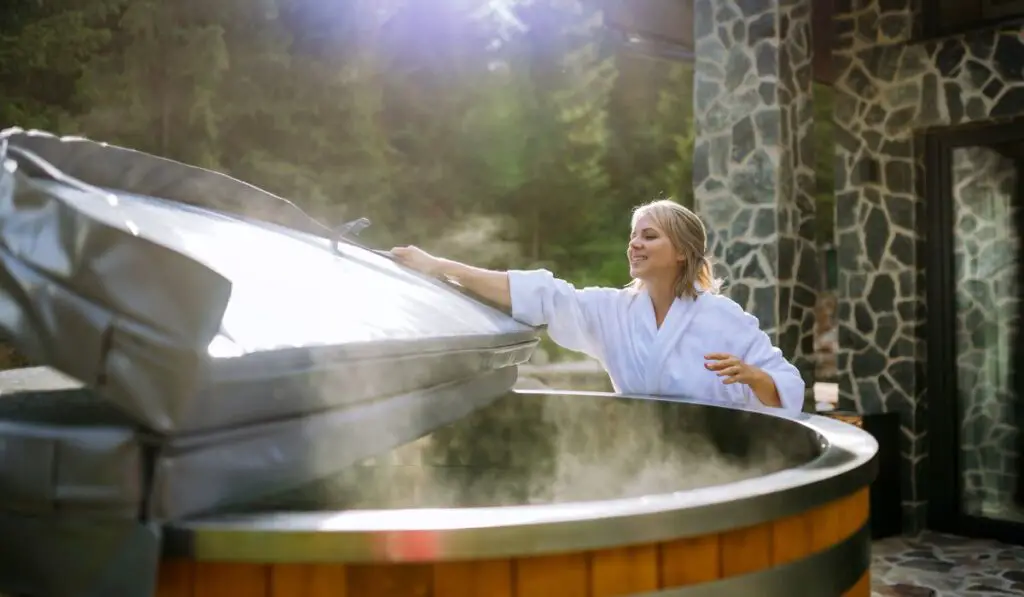If you’ve just purchased a hot tub or found one in your new home, you’re probably wondering how you’re going to keep it warm. After all, those jets and bubbling waters can get pretty chilly if the temperature isn’t just right. Not to worry — we’ve got you covered with this hot tub heating guide.
On average, it takes about 2-4 hours for a standard 6-person hot tub to heat up to 100 degrees Fahrenheit, the optimal temperature for most people. That timeframe depends more or less on the size and location of your tub, the outside temperature, the heater strength, and how warm you like the water.
Heating a hot tub isn’t all that different from heating your regular bathtub, but they’re bigger and can be costly to heat, so it’s important to know how to do it properly. With a few simple tips, you can make sure your hot tub is always ready for a relaxing soak. Let’s look at some common questions about heating hot tubs as well as some tips for doing it efficiently.
How Fast Does a Hot Tub Take to Heat Up?

Generally, hot tubs can take anywhere between 2 and 4 hours to heat up fully, and that’s because they’re big. An average hot tub can hold 350-450 gallons of water, which is heated up with a 220-volt heater and constantly circulated using a jet pump.
As a result, the temperature increases by just 3-5 degrees Fahrenheit per hour, and even slower if it’s a tub with a 110-volt heater.
Other than the internal elements of your hot tub, the surrounding air temperature, wind, and initial water temperature will affect how fast your hot tub takes to heat up.
Which Factors Affect the Heating Process?
Several factors can affect how fast or slow your hot tub heats up. Let’s touch on a few of the most common ones.
The size, age, and make of your hot tub will play a big role in how well it retains heat and how quickly it heats up. Worn-out seals and insulation can contribute to heat loss as well.
The power of your heater, whether it’s 110 or 220 volts, will also factor in. A modern, more powerful heater with better sensors will heat up your tub faster than an old exhausted one.
Now coming to the external factors — if it’s a cold winter day at 50 degrees, it will take your tub longer to heat up to 100 degrees than if it were a balmy summer day at 75 degrees. Additionally, a strong wind can lead to evaporative cooling, making it take even longer for your hot tub to reach its target temperature.
The external factors can be set off by using a cover — an insulated hot tub cover (on Amazon) or even just a regular tarp can help keep the heat in. That way, your tub will work more efficiently and save you money on your energy bill.
And lastly, the base temperature of the water can make a huge difference. If you’re starting with freezing cold water sitting in your backyard hot tub on a winter day, it’s going to take quite a while for your tub to heat all the way up.
On the other hand, by keeping the tub running at a lower thermostat, the initial water temperature will be warmer, and your tub will heat up more quickly whenever you want to use it.
All of these factors can be controlled to some extent, so you can manage your hot tub heating more efficiently.
Do the Jets Help Heat a Hot Tub?
There are some solid arguments on both sides when it comes to using jets while heating. On the one hand, jets circulate the water in the tub, so the heat is evenly distributed. This way, the whole tub — not just the water near the heater — is warmed up.
Additionally, the circulation removes cold pockets that can make sitting in your tub less than enjoyable.
On the other hand, some people believe that running the jets actually slows down the heating process. The reasoning is that the jets increase the heat exchange between the water and air. They also add cold air bubbles into the tub, further cooling down the water.
In the end, it really comes down to personal preference. Any possible effects on the heating process are going to be marginal, so if you want to run the jets while you’re waiting for your tub to heat up, go for it.
Should You Leave Your Hot Tub Running?
If you look at a hot tub’s working and heating mechanism, you’ll notice that they’re designed to be left on and run continuously. Your tub will be more energy-efficient if it’s kept at a lower temperature all the time rather than being turned up to maximum to heat up freezing cold water when you want to use it.
Additionally, you should never turn your hot tub completely off if you live in an area with freezing winters. Freezing water can cause severe damage to the equipment.
However, the choice of whether to keep your tub running or not is ultimately up to you. If you live in a warmer climate and don’t use your tub often, it might make sense to only turn on your hot tub when you want to use it. This can help save you some money on your energy bill.
For colder climates, it’s probably best to keep the tub running, so it’s always warm and ready for use in a few minutes, and you don’t have to worry about the freezing damage.
7 Tips to Speed Up the Heating Process

Now that you understand how the heating process works and what affects how quickly your tub warms up, there are a few other things you can do to help speed up the process. Here are 7 key tips to try yourself.
1. Use a Hot Tub Cover
Using a cover is probably the most effective way to help your tub heat up faster. That’s especially true if you have cold weather and a significant temperature difference between the air and hot water in the tub. Make sure your cover is properly fitting and in good condition to get the best results.
2. Change the Heater / Heating Element
If your tub is older, the heating element might not be as effective as it once was. Even if it’s not worn out, upgrading to a more powerful modern heater can help your tub heat up faster. A good quality heater can significantly affect the energy cost and heating time.
3. Improve Insulation
Though most good hot tub models come with some form of insulation around the walls, they very often skip insulating the base of the tub. This can be a big mistake because a lot of heat is lost from the bottom to the ground. You can improve insulation by adding an extra foam layer between the concrete pad and your tub.
Also, beware of the tiny cracks or gaps in insulation around the tub shell and seal them up — even a small crack can let a lot of heat escape.
4. Keep the Tub Running
It’s generally best to keep your tub running at a low thermostat even when you’re not using it. This way, the water will always be a few degrees warmer and will heat up faster when you’re ready to use it. Though it might add a few dollars to your power bill, it can save you a lot of time in the long run.
5. Shield the Tub From Wind
When the wind blows, it can carry away the heat from your tub, making it take longer to heat up.
You can help prevent this by shielding your tub from the wind. This can be as simple as putting up a windbreak or privacy screen (on Amazon) around your tub. Or, if you have a portable hot tub, you can move it into a more sheltered area.
6. Use Jets
If your tub has jets, you can use them to help circulate the warm water so that it heats the tub more evenly. Just ensure you don’t run them continuously while heating since the jets increase heat exchange with the surrounding air and can slow the process if left running for long.
7. Do Routine Maintenance
Last but not least, it’s important to do regular maintenance on your tub to make sure everything is in good working order.
This includes checking the filters, ensuring the jets are clean, and doing regular checkups of the heater. A well-kept and serviced tub will heat up faster and be more energy-efficient.
By following these tips, you can help your tub heat up faster and enjoy a nice warm soak sooner. Just remember to be patient and give it time to heat up properly to avoid damage.
